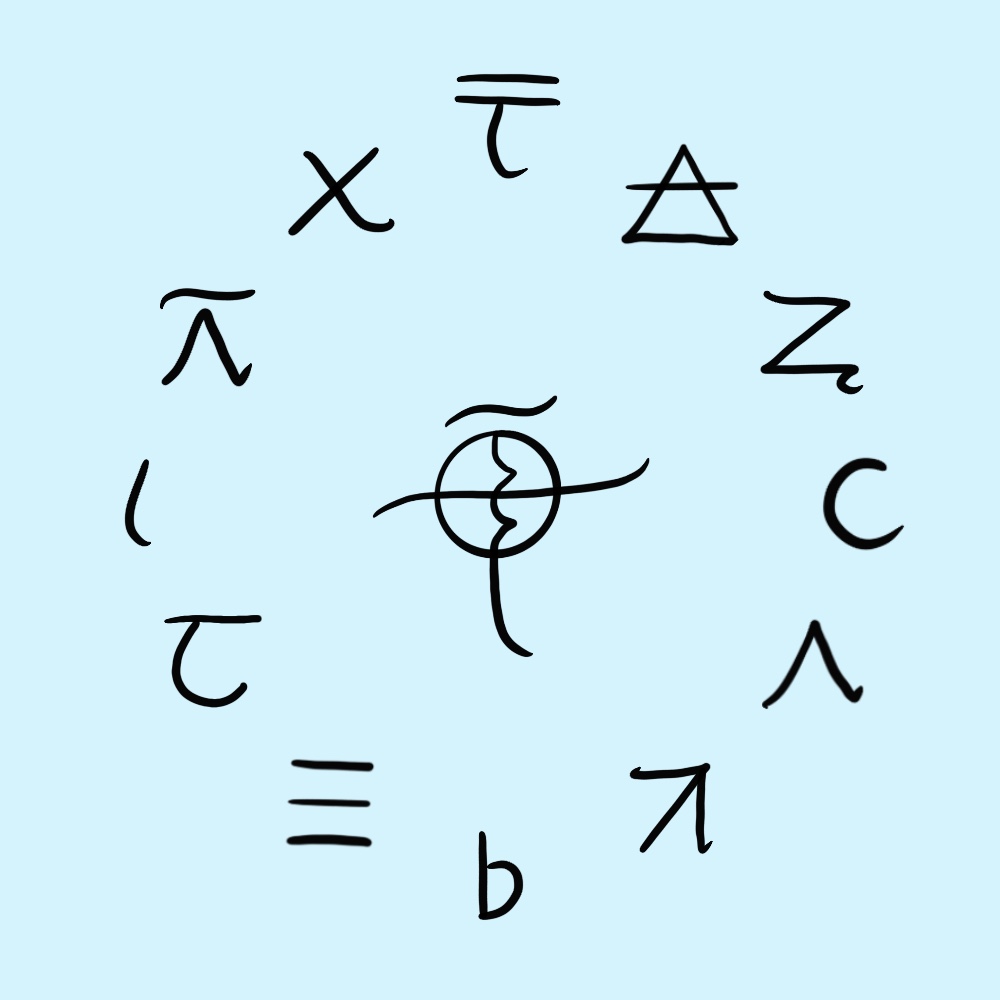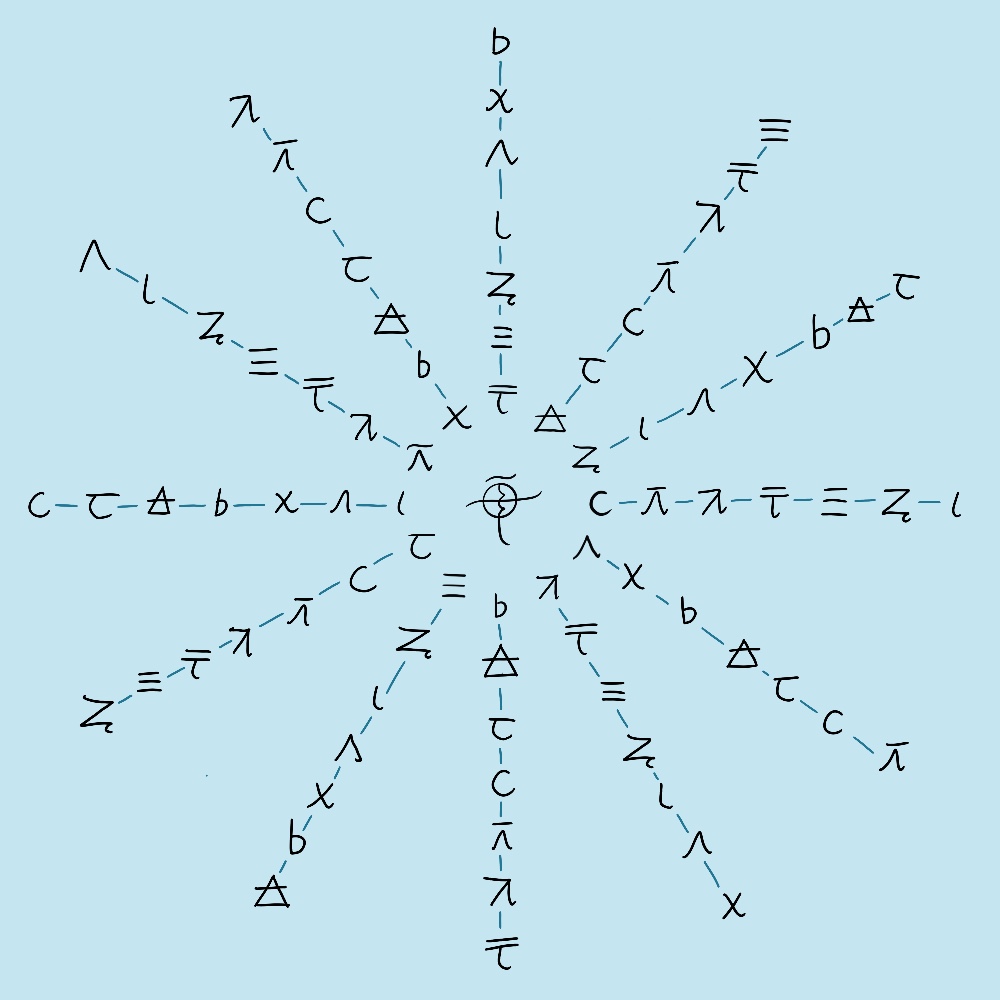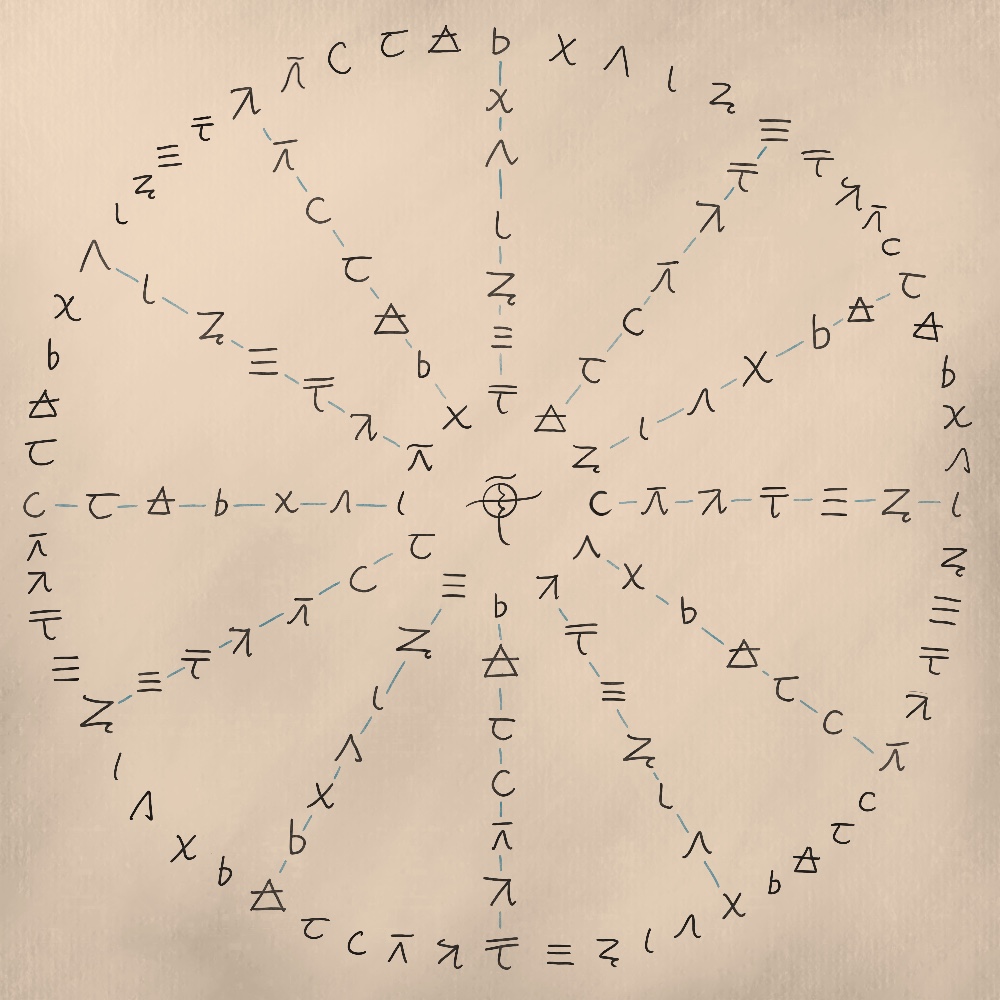Subproject index
Episode 6: tireless hands and perfect arms
Diary of Kaidan Žambey
18 reli 3422 (calten)
Day 4: Trežda to Šerian
Sometimes change trickles; other times it takes hold of an organism whole and shakes it all at once into a new mode of being. So it was with the Sariley and her strange human cargo on the gentle calten morning in which we passed out of the southern countries and into Verdúria.
First, the sun came out, finally banishing the unseasonable chilly fog that has plagued us since Žésifo. Then, the colours arrived. Flowers on trees and riverbanks announced themselves to me, vivid and warm; whether none had been there in Krasnaya, or my mind had been too perturbed to see them, I cannot say. They studded the shining backdrop of the tall spring grass like gems on a velvet robe, which itself was matched and painted into the sky by the many Verdurian flags which heralded our transition into this land of extremes, waving like tireless hands.
The mood aboard began to chatter and buzz with the energy of leaving something old behind. It was the sound of a group remembering it could speak of plans and hopes, rather than wounds and woes. It even swept me up; I forgot, while the sun shone and the boat flew on, Como and my disgrace, my worries for Kutro and father, my near-dead career.
I burbled about where I might disembark and what I might do then with a sailor named Virny, who was spending an hour at rest catching the sun on top of the quarterdeck. We were joined by a mysterious young lady named Mëfa, who seems to be travelling alone, though under the protection of Gn. Sfica, and I’d wager anything was a post-noble runaway like me. Mëfa and I both said we were unsure about staying on all the way to Verdúria city; I joked that the chaos of Dobray had been quite enough for me, and said I fancied my chances to try for employment in Ulian or Vyat, where I would not be so far from home. (Of course, finding out Como's fate was foremost in my mind, which I kept to myself.)
But Virny said simply that Imdaluát and Cuéndimar in Verdúria were not to be missed – that he was going to stay the whole week in the city and return on the next boat – and stretched out his perfect arms in the sun to make a pillow for his head. We both changed our tune – cast, I think, under the same spell. Perhaps I will stay on, and learn to celebrate a king to whom I owe no fealty, with Virny’s Verdúria-style cool.
We stopped at noon at Tregör to pass customs. I remembered the border official from my journey up to see Elucöra: a cheeky old man with a pun for every occasion. He took my letter without incident, changed two of my nine remaining
besimî, and quipped with me something about the restlessness of youth. (I will have to start earning money soon! My letter of credit should be saved for when I secure a post, so I might afford a few home comforts.)
I chose not, as the light drew in and we pulled into the faded splendour of Šerian, to remember the spot just beyond the docks, where I’d changed onto horseback in autumn for the remainder of the journey to Ulian – the spot where I’d seen, with a jolt, Como again, leading two horses, one to be his and one to be mine.
I disembarked again, and found a riotous inn at the edge of the sailors' district, underneath the steep Prosia Ataboë. I batted off notice of its unfortunate name: Soa Cumeliräma. Inside, I found a red-faced Kebreni singer with a little round guitar playing folk tunes. How he’d got there was anyone’s business. He was most interesting to speak to (in stilted Verdurian) about the way they teach music in Kebri. They call the notes, I found, by the same as our short names (en, vi, bo…) though they have a few different ones (en is actually e in Kebri). He said, if I understood him right, that the reason we call Ṃëranac ‘ma’ and not ‘mër’ is because it is taken from the Kebreni! He had a good bottle of wine on his table which he let me share, in return for a song. I did ‘So Šadec Gödoi’, which was fun, as he knew it, and he and a motley crowd that hazed around us joined in. He knew some rather funny words, and (with respect to him) they came out through a thick filter of drunken imprecision, which made it all the funnier.
Notes
calten - I worked out that the first day of Kaidan's journey, 15 reli 3422, was in fact a scúreden; I will go back and change the other entries, as it makes sense. The barge leaves Žésifo on scúreden, i.e. what essentially is Monday morning, and aims to get to Verdúria city by néronden (market day) 12 days later, resting overnight to maximise cargo space and avoid the risks of sailing in the dark.
post-noble - Kaidan’s sardonic Verdurian term is
samelašte ‘through-noble’, modelled on
sabelgom ‘veteran’ (lit. ‘through-war-person’). He may be referring to two factors here: firstly, his current disgrace, though he certainly hopes this is temporary. Secondly, his family’s noble title having been downgraded with the reassertion of Ctésifonian independence ‒ see the Prelude.
journey up to see Elucöra... changed onto horseback - Kaidan visited Ulian in the fall of 3421 to spend more time with his then-fiancée Elucöra Revouse and meet her family. (Como was Elucöra’s father’s stablehand.) That fall, Kaidan had travelled by ship from Žésifo to Šerian, though in a swifter vessel of a higher class. He then rode from Šerian to Ulian, cutting out a bend in the Svetla, guided by Como who had been sent to meet him. It had been a costlier, but significantly quicker journey; see Episode 1.
Imdaluát and Cuéndimar - Imdaluát is Coronation Day in Verduria, the second of King Vlaran; naturally Kaidan wouldn't be too knowledgeable about it, being from Ctésifon. Cuéndimar is the week-long Great Festival in honour of Enäron. In Vlaran's reign they fall in the same week.
customs - I don't know whether there would be a border official at customs in Tregör; it seems likely that this is the point of the settlement, which has nothing else published about it that I can find.
besimî... letter of credit - Kaidan has some coins sewn into his clothes; he also carries a letter of credit (in addition to his license letter allowing him to travel aboard) which he will be able to change at a temple for a larger sum of money.
faded splendour - Šerian (from Caď. ‘palace place’) was a winter retreat of the Caďinorian emperors, and contains some of the best-known Caďinorian ruins.
Prosia Atraboë - Emperors' Street
Soa Cumeliräma - The Fiancée (lit. ‘the one (f) to live with’)
little round guitar - probably a soprano čište of some kind; in 3422, for a Ctésifonian, these instruments are probably rare enough that Kaidan handwaves its actual name, at least when writing tired and a little drunk. However...
the way they teach music in Kebri - the episode highlights the growing interconnectedness of wider Eretald's musical culture: a Kebreni in Šerian knows a Muďucan folk song in broken Verdurian, and uses a musical language which, with some variations, is shared between the two cultural spheres.
en vi bo - shortenings of the note names presented in Episode 5. Some of the modern standard shortenings are indeed Kebreni in origin, and Kaidan actually uses the Kebreni variant of
ve/vi without realising it, as it is in more or less free variation with its Verdurian counterpart across Eretald. As Kaidan learns,
ma derives from Kebreni
mardah́ rather than Verdurian
Mëranac, and
se,
ke/ře and
na similarly show Kebreni influence.
So Šadec Gödoi - a folk song from Muďuca, lit. ‘the rider/messenger of/from Gödo’. I don't have any words for it yet, but it is supposed to evoke thundering hooves as a messenger rushes from a neighbouring city ‒ my imagination says, perhaps with a pardon for an execution which is due at dawn.
The Eretaldan-Kebreni musical culture
The standard Caďinorian note names and visual representations thereof as capital letters with a lower dot (ẸṾC̣...) have been around for over a millennium (since the Aďivro), and they were synthesized into Kebreni by being given compatible Kebreni names around 2743, when Kebreni scholars set about combining Caďinorian law with native traditions. Thus a hybrid Kebreni-Eretaldan musical culture has been in existence, at least on some level, for around 750 years. (Though there is a great deal of local variation across this culture: they simply have the same shared base musical ‘language’.)
Here is a diagram of note names in Verdurian and Kebreni, with little pictures to show the meanings of the Kebreni long-form note names. (Apologies for a few misspellings, including ‘Osureon’ for ‘Oruseon’. Perhaps the drunken Kebreni did it.)
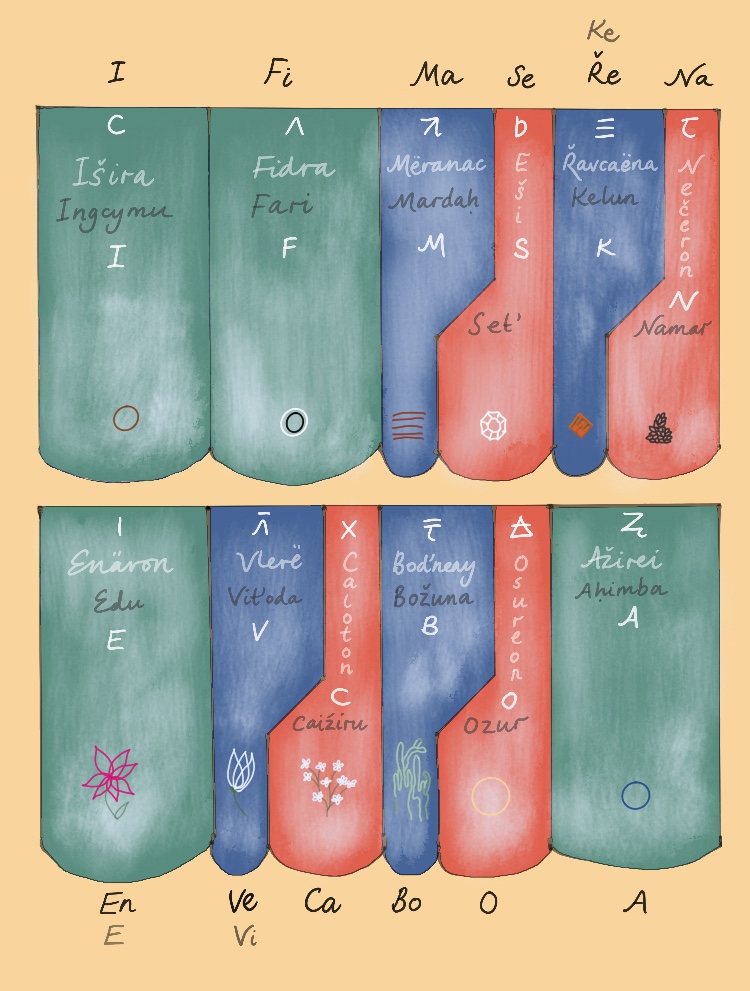
In the table below, the middle column shows the direction of borrowing. This was not a formal process, but organic, as musicians from Eretald proper and Kebri interacted, worked together, and shared notation. (It's probable that a lot of this synthesis happened in Érenat.)
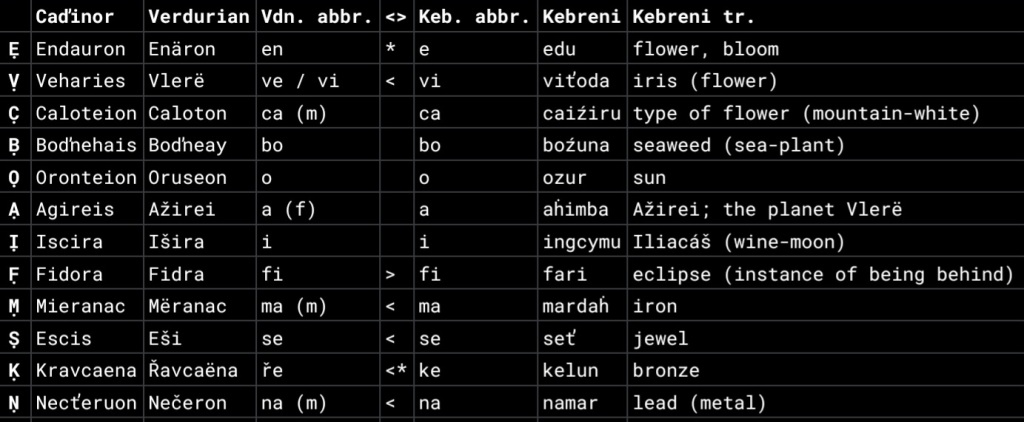
You can listen to me practicing ‘So Šadec Gödoi’
here, and below is a piece of tablature for its main theme, as might be familiar to (or written out by) both Kaidan Žambey and the Kebreni singer in 3422. I'll discuss notation another time; but this is a sneak peek.
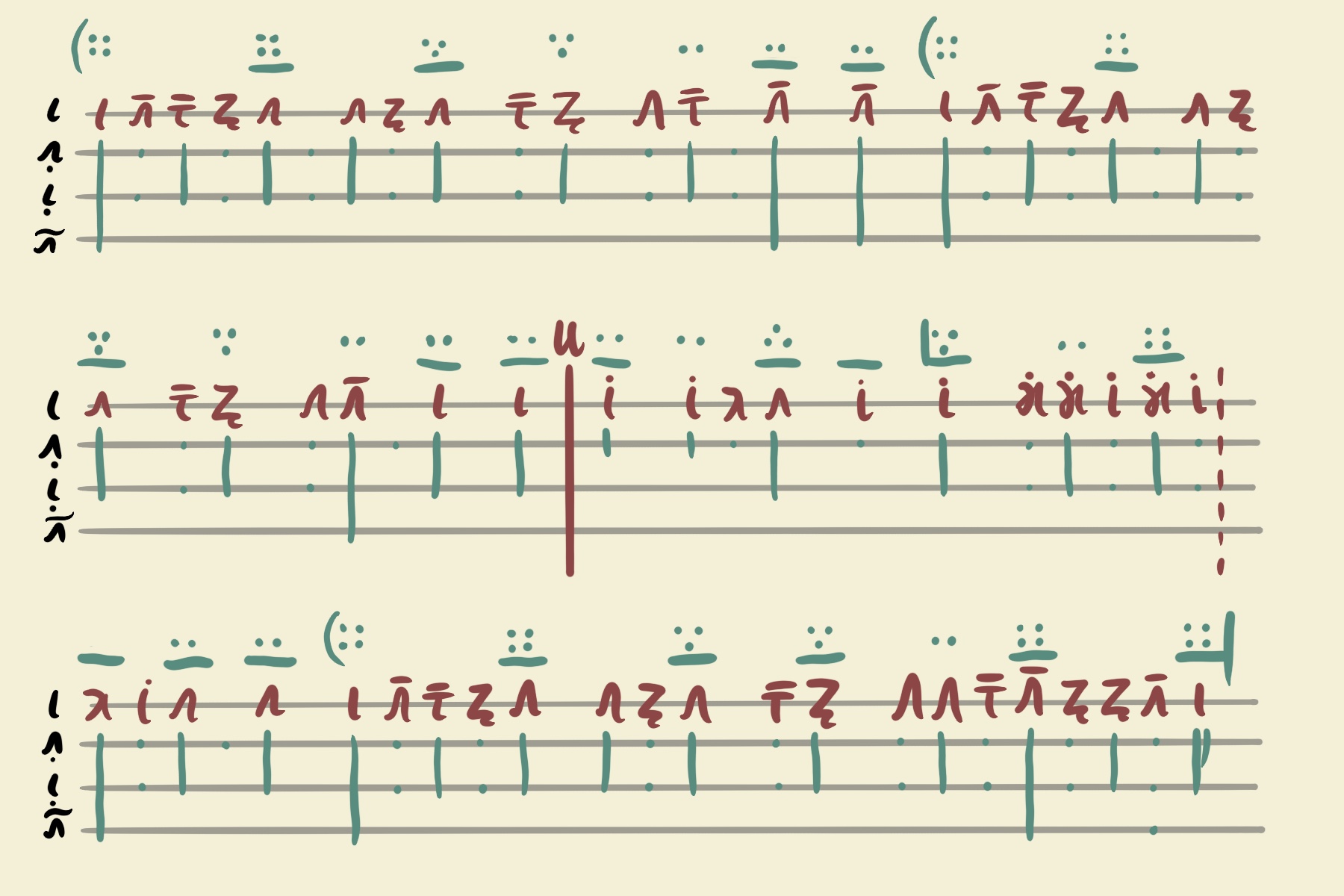
The scale which forms the main theme is the first of what are known in Ismahi as the ‘split tone modes’ (about which I will say more another time); these modes were associated with the eastern part of the Empire in late classical times, and (in the Aďivro) named after rivers in the region. In this classification the scale is the
čimora Seree, or Serean scale; it contains the notes ẸṾḄẠF̣ṢṆ, and is colloquially known in Verduria as ‘
evbafešne’.
We might call it the ‘Neapolitan major scale’, while in South India it is called Mela Kokilapriya, being the 11th numbered Melakarta ragam. However, in the higher second theme, the note C̣ appears instead of Ṿ, and Ṃ instead of Ṣ; we could say we've switched to the
čimora Adelei or Aeolian mode, or instead evoke the trick of changing the notes in the scale/gamut which makes up the tune when entering a higher octave, which is commonly found in Japanese traditional music.



